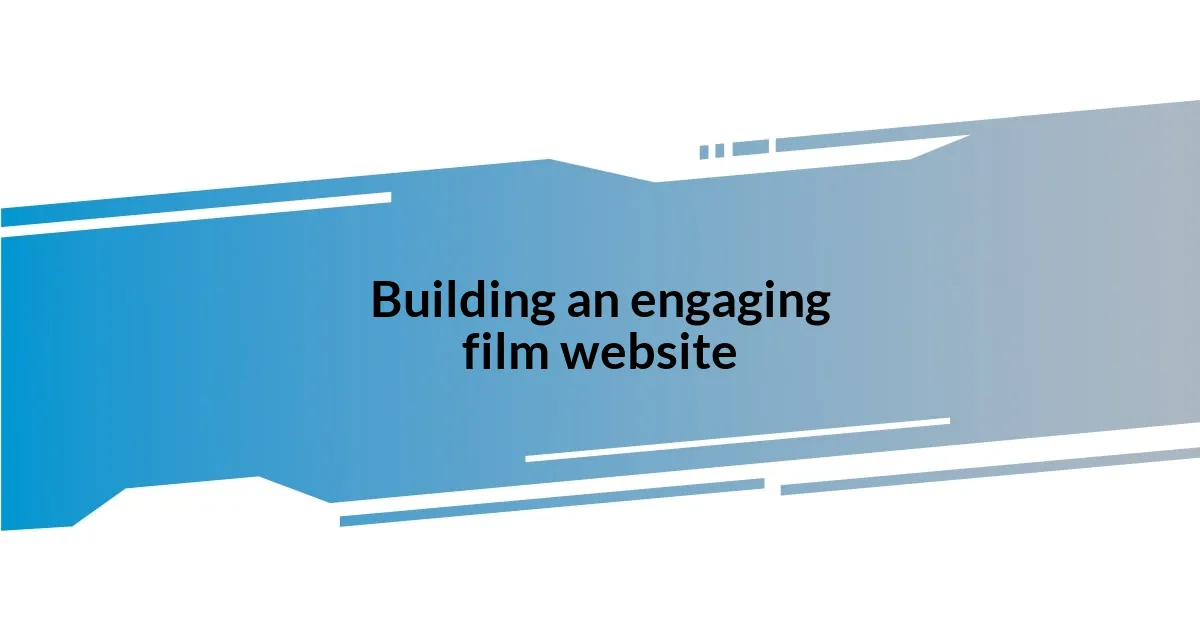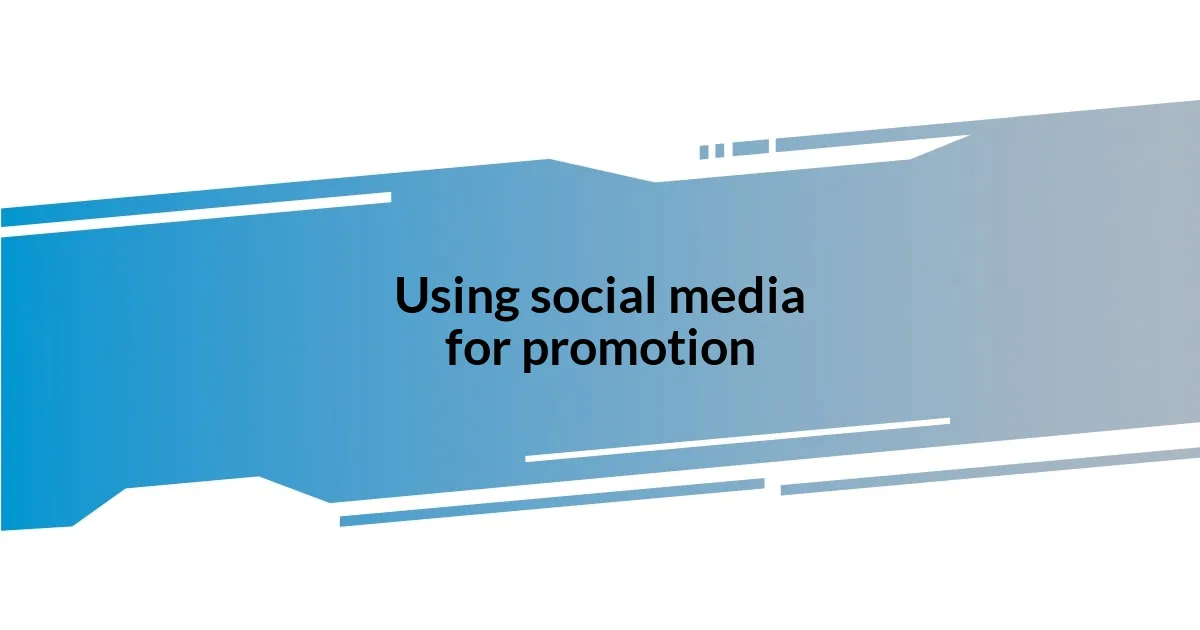Key takeaways:
- Understanding your audience’s psychographics and preferences is crucial for effective independent film marketing.
- Building an engaging film website with strong visual design, interactivity, and mobile optimization enhances viewer connection and experience.
- Leveraging social media and connecting with film influencers significantly amplifies promotion efforts and fosters community engagement.

Understanding independent film marketing
Independent film marketing is a nuanced journey shaped by resourcefulness and creativity. From my experience, I find that understanding your audience is half the battle. Have you ever sat in a theater and surveyed the crowd, wondering who they are and what makes them tick? That insight is invaluable.
Choosing the right marketing channels can feel overwhelming. I remember when I launched my first film; social media was my playground, where I engaged directly with potential viewers. I discovered that organic conversations sparked genuine interest. Isn’t it fascinating how a simple post or a well-placed tweet can ignite excitement for your project?
As I navigated this landscape, I learned that storytelling goes beyond the film itself; it encompasses the entire marketing approach. Connecting emotionally with your audience—sharing your journey and the film’s themes—resonates deeply. Have you thought about how your story can foster a connection? I have found that vulnerability in sharing my challenges and triumphs creates an authentic narrative that draws people in.

Defining my target audience
To truly define my target audience, I first dive deep into understanding their psychographics—what they enjoy, their values, and what resonates with them emotionally. I vividly recall sitting in a café while brainstorming ideas for my film; I jotted down specifics about the kind of viewer I wanted—those passionate about indie films, who appreciate authentic storytelling and unique visuals. This clarity not only guides my marketing efforts but helps me craft messages that feel personal and relatable.
Here’s a quick overview of the points I consider when defining my target audience:
- Demographics: Age, gender, location, and occupation play a critical role in shaping my film’s outreach strategies.
- Interests and Hobbies: Identifying what they enjoy outside of cinema can provide insight into where and how to connect with them.
- Communication Preferences: Do they respond best to Instagram stories or Facebook events? Understanding their preferred channels is crucial.
- Values and Beliefs: Knowing what drives them emotionally allows me to tap into those motivations and highlight relatable themes in my marketing.
- Viewing Habits: Are they more inclined to watch films online, at festivals, or in local theaters? This shapes not just my promotional efforts, but also release strategies.
By weaving these elements together, I create a clear picture of who my audience is, allowing me to engage with them in a meaningful way.

Building an engaging film website
Building an engaging film website starts with defining its core purpose. I remember when I crafted my first film website; I wanted it to not just showcase the film, but also to reflect the essence of the story. The color palette, fonts, and images were all carefully selected to create a specific mood. Creating a visual narrative on your homepage can immediately draw visitors in and give them a taste of the film’s vibe—ask yourself, does your website speak to your film’s heart?
Another key element is interactivity. Incorporating features like a blog or a behind-the-scenes section invites visitors to engage more deeply. I found that as I shared my creative process—like brainstorming sessions or location scouting—viewers felt more connected. What struck me was the feedback I received; people loved the idea of being part of the journey. It’s crucial to give your audience a stake in the story even before they’ve seen the film, right?
Lastly, optimizing for mobile use cannot be overlooked. Most potential viewers will discover my film on their phones. I still recall learning that the hard way; after realizing my initial website design struggled on smaller screens, I quickly adapted. Keeping layout simple and ensuring easy navigation makes a world of difference. How accessible is your site across devices? Consider this: if your audience can’t explore your website seamlessly, you might lose potential fans before they ever hit the play button.
| Website Element | Why It Matters |
|---|---|
| Visual Design | Creates an emotional connection and reflects the film’s tone |
| Interactivity | Engages the audience and fosters a sense of community |
| Mobile Optimization | Makes the site accessible to a broader audience on various devices |

Using social media for promotion
Harnessing social media for film promotion is a game-changer—I’ve seen it firsthand. I remember launching my film’s social media campaign; it all started with posting behind-the-scenes content that really connected with my followers. Those glimpses into my creative process stirred excitement and gave them a sense of ownership over the project. Have you ever wondered why sneak peeks resonate so well? It’s because they let potential viewers feel like they’re part of the journey, not just bystanders.
On platforms like Instagram and Twitter, I’ve found that authenticity reigns supreme. One of my best strategies was interacting with my audience through live Q&A sessions. I once shared personal stories about the challenges and triumphs during filming, which ignited some deep conversations. This not only bolstered my film’s visibility but also fostered genuine connections with fans. It’s interesting to note how sharing personal anecdotes can humanize the often intimidating world of filmmaking.
Engagement doesn’t stop with content creation; utilizing social media stories and polls can be incredibly effective, too. I frequently ran polls asking followers about their favorite film genres or even which poster designs they liked best. The feedback was invaluable and made my audience feel seen and heard. What I realized was that social media is not just a broadcasting platform; it’s a lively community where fans can actively contribute to the evolution of the film. Are you tapping into this potential? If not, you’re likely leaving an untouched well of creative collaboration on the table.

Creating compelling film trailers
Creating a compelling film trailer is like distilling the essence of your entire movie into a dynamic, bite-sized experience. I remember crafting my first trailer and deciding to feature just enough intrigue to hook viewers without revealing too much. It’s a fine balance—if you give away the plot twists, where’s the mystery? I always ask myself, “What would make me stop scrolling and hit play?” This thought process drives my trailer content.
Another critical aspect is the pacing and rhythm of the trailer. I found that syncing powerful visuals with a gripping soundtrack elevates the emotional impact, making viewers feel something within seconds. When I edited my trailer, I meticulously chose moments that conveyed the film’s tone—be it tension, humor, or drama. Did you ever notice how some trailers can transport you to another world, even for just a few minutes? That’s the kind of engaging experience I strive for; the goal is to leave potential audiences excited, wanting more.
Lastly, I think it’s essential to include a call to action at the end. When I finished my trailer, I didn’t want to let viewers off the hook; I aimed for something that compelled them to follow the film’s social media, visit the website, or mark the release date. It’s that little push that can convert casual viewers into passionate fans. So, what are you doing to turn intrigue into action? Your trailer should not only entertain but also guide viewers into engaging with your project further.

Leveraging film festivals for exposure
Attending film festivals has been a transformative experience for my film’s visibility. The energy at these events is palpable, with filmmakers and audiences coming together to celebrate creativity. I remember my first festival experience; after screening my film, I received immediate feedback from viewers, which was both exhilarating and nerve-wracking. Did you know that festivals often serve as a breeding ground for crucial networking opportunities? It’s like being handed a golden ticket to connect with industry professionals, distributors, and even fellow creators.
I’ve discovered that showcasing your film at festivals isn’t just about the premiere; it’s about the relationships you build. For instance, I met a distributor during a Q&A session after my screening who later played a key role in my film’s distribution. Attending workshops and panels at these festivals has also enhanced my understanding of the market, giving me insights into what audiences are looking for. Have you ever thought about how these events can create lasting connections for future projects? It’s a powerful reminder that each interaction has the potential to shape your film’s journey.
What truly struck me was the sense of community at these festivals. Everyone is there, rooting for one another, which fosters an environment of support and collaboration. After one festival, I hosted an informal meetup in a local café with other filmmakers, which led to brainstorming sessions and even co-production ideas. If you’re considering entering the festival circuit, embrace the whole experience. Each festival not only exposes your film to new audiences but also offers rich opportunities for collaboration and growth that you might not expect.

Connecting with film influencers
Connecting with film influencers has become an essential strategy in my marketing toolkit. When I made the leap to reach out to a few influencers in my niche, I was surprised by how welcoming and supportive they were. I still remember the thrill of getting a positive response from an influencer whose work I admired. It made me realize that many influencers genuinely want to help independent filmmakers by providing exposure and authentic engagement. Have you ever considered how a single shout-out from the right person could elevate your project?
I found that personalizing my approach was key. Instead of sending generic messages, I took the time to craft heartfelt notes that explained what my film was about and why I felt it resonated with their style. One influencer even remarked on how refreshing it was to receive a genuine message rather than a cookie-cutter pitch. Building these relationships isn’t just about asking for help; it’s about fostering meaningful connections. Don’t you think a personal touch can make all the difference in the world?
Another effective tactic has been to engage with their content actively. By commenting on their posts, sharing their insights, and genuinely showing interest in their work, I created a foundation for interaction. I remember being invited to a live Q&A with one influencer after consistently engaging with their content. It was not only an honor but also an opportunity to share my film with their audience. So, how do you plan to connect with film influencers? Building these relationships can lead to a network of support that enhances both your marketing efforts and your creative journey.
